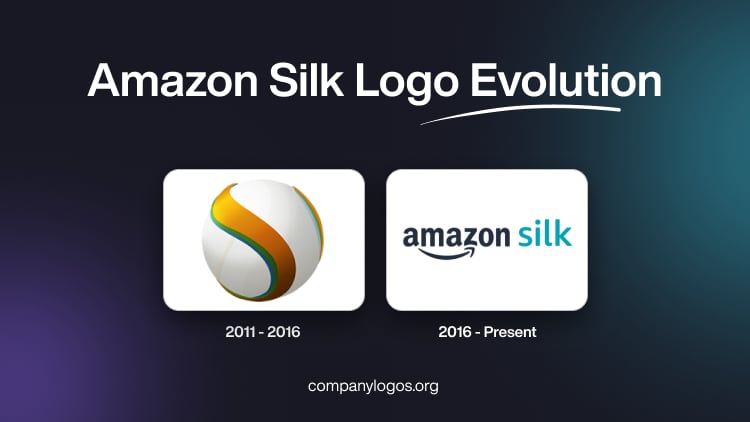
Amazon Silk is a specialised, cloud-accelerated browser that is designed for the Amazon ecosystem. While it did not become a mainstream browser, it remains an integral part of Fire tablets and Fire TV. The Amazon Silk logo has evolved since the browser’s debut in 2011. It moved from being a standalone identity to being an integral part of Amazon’s unified brand system. The key logo changes occurred in 2011 and 2016. The article delves into the evolution of the Amazon Silk logo, among other details of the company.
The Genesis of the Amazon Silk Logo (2011 – 2016)
When the Amazon Silk browser was launched in 2011 for the Kindle Fire, it featured a distinct wordmark emphasising the lowercase word “silk” with smooth lines in orange colour. Below it was mentioned the word “BROWSER” in white uppercase. To the left of the wordmark was positioned an emblem consisting of a white ball-like element.
Further, an orange and green coloured ribbon-like element was wrapped around the ball to resemble the letter “S”. The original Amazon Silk logo design sought to convey speed, fluidity, and advanced technology, and it positioned Silk as both lightweight and innovative.

(2016 – Present)
In 2016, Amazon Silk underwent a visual update. It began to incorporate more explicit connections to Amazon’s main corporate identity. These often include the Amazon wordmark or subtle echoes of the iconic Amazon smile-arrow. Here, the wordmarks “amazon” and “silk” are placed side-by-side in lowercase and in black and light green colours, respectively. The arrow sign, reminiscent of the original Amazon logo, appears in black. The emblem “S” with pointed ends was redesigned in gradient orange against a white background. The bottom end of the letter “S” shows the colour grey as a shadow.


The Elements of the Amazon Silk Logo
Font
The font used to render the Amazon Silk logo is Amazon Logo Sans. It was developed for Amazon’s 2025 global rebrand as an evolution of the earlier Amazon Ember typeface. Amazon Sans is a logo font that is proprietary and has been designed to unify Amazon’s visual system and provide excellent legibility on digital platforms. The wordmark in the earlier versions of Amazon Silk was written using a lighter and rounded sans-serif typeface.
Colour
The colour scheme used to design the Amazon Silk emblem features Smile Orange (a specific Amazon brand orange). The text (including the Silk name) typically appears in black and light green, respectively. It reinforces clarity and accessibility. The colour Smile Orange is chosen for its warmth, friendliness, and brand distinctiveness.
The History of Amazon Silk
Amazon Silk is a web browser developed by Amazon and launched in November 2011. It was released as the default browser for Kindle Fire tablets, with the name “Silk”. This was done to highlight the invisible yet strong connection between the device and Amazon’s cloud servers. The browser distinguished itself from competitors by using a unique split architecture.
In this architecture, some amount of web page processing occurs locally on the device, and the rest is offloaded to Amazon’s EC2 servers. This is done to optimise performance and loading speeds. In 2014, Silk expanded to Amazon’s Fire Phone and later became available on other Fire devices. And responding to the growing popularity of Amazon Fire TV, a Silk version for Fire TV was released in 2017 as well.
In 2018, it was integrated into the Echo Show smart displays, which made browsing possible across the smart device ecosystem of Amazon. Built on the open-source Chromium project and utilising performance-boosting protocols like SPDY, Silk leverages predictive algorithms to preload web pages and compress content. These make it efficient for devices with limited storage or processing power.
While the cloud-based acceleration of Amazon Silk offers speed benefits, it also raises some privacy concerns. This was due to traffic being routed through Amazon’s servers, a feature that users can choose to disable. Importantly, Silk remains unavailable for desktop operating systems and instead focuses exclusively on Amazon’s own range of tablets, streaming devices, and smart speakers.
Interesting Facts About Amazon Silk
- Amazon Silk debuted alongside the first Kindle Fire tablet in September 2011 as its default browser.
- One of its unique selling points was that it used Amazon’s EC2 (Elastic Compute Cloud) servers to split the workload between the device and the cloud, which made the browser faster.
- Silk could decide whether to render web content on the device or on Amazon’s servers, thereby optimising for speed and performance.
- Amazon’s cloud could compress images and videos before sending them to the device. This helped users with slower internet connections.
- Early reports suggested Silk could reduce webpage load times and data usage by as much as 60%.
- Silk was designed to learn from collective browsing patterns to predict what pages users might visit next.
- Silk comes pre-installed on Kindle Fire tablets, Fire Phone (discontinued), and Fire TV devices.
- Unlike Chrome, Safari, or Firefox, Silk was not made available for PCs, iOS, or non-Amazon Android devices.
- Since Silk could route traffic through Amazon’s cloud, some privacy advocates raised concerns that Amazon might track browsing behaviour.
- Users could disable the cloud acceleration feature to keep browsing locally and to bypass Amazon servers.
- Silk was extended to Fire TV in 2017, which allowed users to browse websites, stream videos, and even access YouTube via their televisions.
- The Amazon Silk browser was integrated with Alexa for voice-based browsing on Fire TV devices.
- Silk never competed head-to-head with Chrome or Firefox in global market share but became significant in the Amazon ecosystem.
- It was particularly tuned for shopping, Prime Video, and Kindle content.
Finally
The evolution of the Amazon Silk logo reflects the browser’s role within Amazon’s ecosystem. It is simple, lightweight, and service-driven rather than flashy or competitive in the broader browser market. Unlike major browsers such as Chrome or Firefox, Silk never relied on a highly distinctive standalone symbol; instead, its branding evolved to remain harmonious with Amazon’s wider design language. This makes it a streamlined, cloud-optimised browser tailored to enhance Amazon’s devices and services.